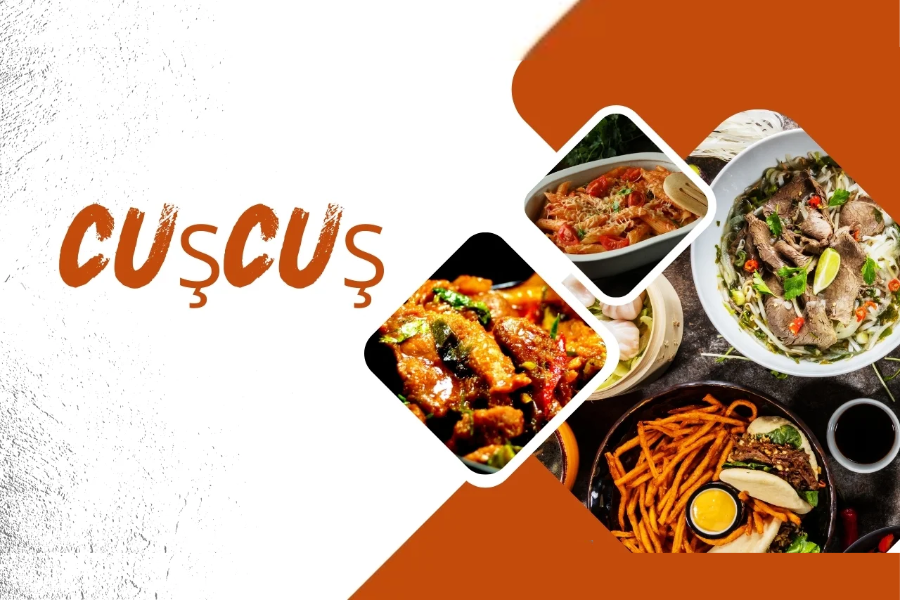Cuşcuş – All Foodies, Attention Here!
Cuşcuş, a dish well established in Center Eastern and Mediterranean foods, has acquired global fame for its flexibility, light surface, and medical advantages. Starting from North Africa, where it is as yet a staple food, Cuşcuş has spread worldwide, tracking down its place in different culinary practices. This article jumps profound into the different parts of Cuşcuş, including its medical advantages, flexibility, and how to integrate it into your dinners.
What Kind of Dish is Cuşcuş?
Cuşcuş is a type of semolina made from durum wheat, which is steamed to create tiny granules. It shares some similarities with rice but is actually a form of pasta. The process of making Cuşcuş involves rolling durum wheat semolina into small grains and then steaming them to achieve its distinctive light, fluffy texture.
Although it can seem like rice, cuşcuş is a savory grain-based meal that’s frequently eaten with grilled vegetables, salads, or robust stews. It absorbs tastes and ingredients from the adjoining foods, making it more like pasta even though it is usually served as a side dish or as a foundation for a main entrée.
Is Cuşcuş a Type of Rice or a Sweet Dish?
Cuşcuş is not a type of rice or a sweet dessert. Made from durum wheat semolina, it is a savory grain that resembles pasta and is ideal as a foundation for savory recipes including salads, soups, and stews. When paired with vegetables, meat, or seafood, the lighter texture and subtle nuttiness of Cuşcuş create a delicious contrast to rice.
In traditional Moroccan cuisine, Cuşcuş is often prepared as a main dish served with vegetables, lamb, chicken, or even seafood, cooked slowly in a rich, flavorful broth.
Is Cuşcuş Healthy?
Indeed, Cuşcuş is viewed as a good food choice. It is low in fat, contains no cholesterol, and gives complex carbs that supply consistent energy. It is additionally a wellspring of dietary fiber, fundamental for stomach related wellbeing, and contains significant minerals like iron, magnesium, and B nutrients.
Cuşcuş can be a sound expansion to any dinner when matched with lean proteins and a lot of new vegetables, making it a fair dish that upholds in general prosperity. The high fiber content can assist with managing processing and keep you feeling more full for longer, diminishing the probability of indulging.
Who Can Have Cuşcuş?
Cuşcuş is a flexible dish reasonable for a wide assortment of dietary inclinations. It is normally vegan and can be made sans gluten with the utilization of elective grains. Because of its gentle flavor and light surface, Cuşcuş is kind with the stomach and reasonable for individuals of any age, from kids to older people.
Youngsters will partake in Cuşcuş’s delicateness and can profit from the perplexing starches it accommodates supported energy. For old people, Cuşcuş’s edibility and low-fat substance make it an optimal choice for a supporting dinner. It is likewise perfect for those following a veggie lover or vegetarian diet, as it very well may be matched with a variety of vegetables, vegetables, or tofu.
What Benefits Does Cuşcuş Have?
Cuşcuş is a great complement to a balanced diet since it provides a number of health advantages.
1. Rich in Complex Carbohydrates
Cuşcuş is essentially made out of mind boggling carbs, which give enduring energy. Dissimilar to basic sugars, complex carbs discharge energy gradually, assisting with balancing out glucose levels and forestall energy crashes. This settles on Cuşcuş an incredible decision for keeping up with supported energy over the course of the day.
2. Low in Fat and Cholesterol-Free
Cuşcuş is typically low in fat and contains no cholesterol, making it a heart-decent food. An eating routine well off in low-fat, without cholesterol food sources maintains sound cholesterol levels and diminishes the bet of coronary sickness.
3. Source of Essential Nutrients
Iron, magnesium, and the B vitamins (thiamine, riboflavin, and niacin) are among the many vital components found in cuscuş. Red blood cell creation, energy generation, and general health all depend on these nutrients. In instance, magnesium is necessary for healthy bones and promotes the function of muscles and nerves.
4. Dietary Fiber for Digestive Health
Cuşcuş contains a sound measure of dietary fiber, which is key for stomach related wellbeing. Fiber keeps up with ordinary defecations, forestalls blockage, and supports the development of useful stomach microbes. Moreover, fiber helps with weight the board by advancing a sensation of completion, diminishing the inclination to gorge.
5. Versatility in Culinary Applications
Past its nourishing advantages, Cuşcuş’s flexibility in cooking makes it a go-to fixing in kitchens around the world. It tends to be served hot or cold, making it ideal for plates of mixed greens, pilafs, or side dishes. Cuşcuş retains the kinds of stocks, spices, and flavors, making it a fresh start for a wide assortment of dishes.
6. Suitable for Various Dietary Preferences
Whether you’re veggie lover, vegetarian, or following a without gluten diet, Cuşcuş is versatile. It coordinates well with a wide cluster of fixings, including vegetables, vegetables, and proteins, making it a nutritious and filling dinner for anybody.
Also Read: Cecilia Chesnor: A Detailed and Descriptive Overview
Who Can Enjoy Cuşcuş?
Cuşcuş is a dear dish across the globe and can be thoroughly enjoyed by people of all ages and establishments. Its light, delicate surface and subtle taste settle on it an ideal decision for youngsters, adults, and seniors. Whether filled in as a side dish or as a central, Cuşcuş can without a doubt be changed to meet individual inclinations and dietary necessities.
Is Cuşcuş Good for Children?
Totally! Cuşcuş is an extraordinary decision for youngsters because of its gentle flavor and simple to-bite surface. It very well may be made more interesting to kids by blending in vegetables, proteins, or even sweet flavors like raisins or dried apricots. Serving Cuşcuş as a feature of a decent feast gives kids fundamental supplements that help their development and improvement.
Can My Grandma Take Cuşcuş?
Indeed, cuşcuş is a great snack for senior citizens since it is easy to digest and mild on the stomach. It may be tailored to older folks’ preferences and needs due to its mild texture and adaptability in preparation. When combined with easily digested items like stewed chicken or soft vegetables, cuscus may be a filling and healthy choice.
Ingredients for Cuşcuş
To make Cuşcuş, you only need a few simple ingredients:
- Durum Wheat Semolina: The base ingredient, finely ground from durum wheat, forms the small granules of Cuşcuş.
- Water or Broth: Used to cook the Cuşcuş, providing moisture and flavor.
- Salt: For seasoning, to enhance the flavor.
- Olive oil: Gives the food depth and richness.
- Fresh Herbs (Optional): Herbs like parsley or mint can be used for garnish, adding freshness.
- Vegetables (Optional): Bell peppers, tomatoes, or other vegetables can be mixed in to boost nutritional value.
How to Make Cuşcuş – 3 Simple Steps
Step 1: Preparation
Begin by measuring the Cuşcuş, typically using a ratio of 1 cup of Cuşcuş to 1 ¼ cups of water or broth. You can also toast the Cuşcuş in a dry skillet for a few minutes to bring out its nutty flavor.
Step 2: Cooking Cuşcuş
In a saucepan, bring the water or broth to a boil and add salt or olive oil for seasoning. After the pot reaches a boil, add the Cuşcuş, cover, and lower the heat to low. Simmer for around ten minutes, or until the grains are soft and the liquid has been absorbed.
Step 3: Fluffing and Serving
After taking the saucepan off of the burner, let it covered for a few minutes. To make the Cuşcuş light and fluffy, use a fork to separate the grains. Serve right away as a side dish or as a foundation for salads, stews, or roasted veggies.
Can I Serve Cuşcuş at Parties?
Indeed, Cuşcuş is ideal for parties. Its flexibility and capacity to serve an enormous number of individuals go with it an optimal decision for social occasions. Whether served hot as a pilaf or cold as a reviving plate of mixed greens, Cuşcuş adds surface and flavor to various dishes. It coordinates wonderfully with barbecued meats, broiled vegetables, or various sauces, making it a group pleaser that everybody will appreciate.
3 Best Alternatives to Cuşcuş
If you’re looking for alternatives to Cuşcuş, here are three great options:
- Cassasse: Similar to Cuşcuş, but made from barley or millet. It offers a light, fluffy texture and is popular in Mediterranean cuisines.
- Farro: An ancient grain known for its chewy texture and nutty flavor, rich in fiber and protein, perfect for salads or as a side dish.
- Millet: A gluten-free grain with a mild flavor that cooks to a light, fluffy texture, making it an excellent substitute for Cuşcuş.
Is Making Cuşcuş Budget-Friendly?
Without a doubt, Cuşcuş is incredibly sensible. The essential fixing, durum wheat semolina, is conservative and immediately open in many general stores. With essential trimmings like water, salt, and olive oil, Cuşcuş can be prepared on a cautious spending plan, offering a nutritious and satisfying banquet that won’t consume every single dollar.
Final Thoughts
Cuşcuş is a supplement thick, flexible, and scrumptious dish that can be delighted in by everybody, from kids to seniors. Whether you’re searching for a sound side dish, a base for stews, or a reviving serving of mixed greens fixing, Cuşcuş possesses all the necessary qualities impeccably. Simple to get ready, nutritious, and profoundly versatile, a food unites individuals. In this way, whenever you’re needing a delicious, filling dish, make sure to Cuşcuş!
If You Want To Learn More Information And Updates So Please Visit: BlogVibe.co.uk






